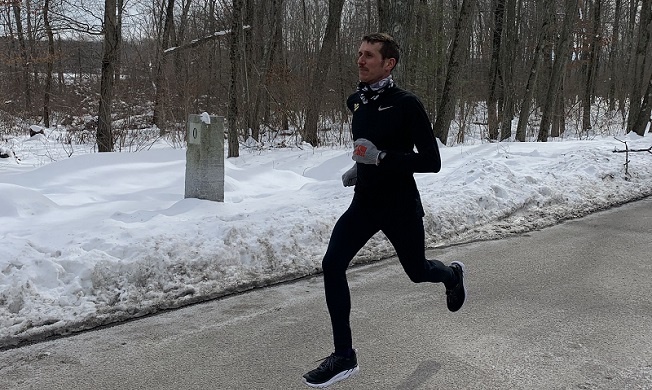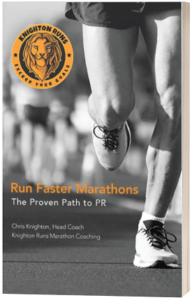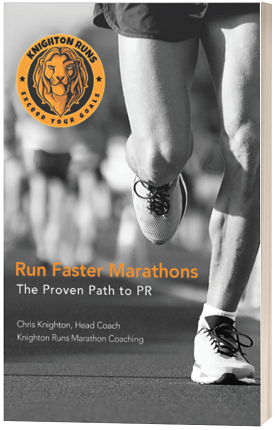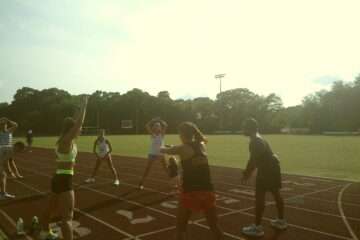The Six Phases of Marathon Training
Focus on one aspect of training at a time to run your next marathon faster.
This post was written by Coach Chris Knighton

There are six phases of marathon training. In each phase, you will focus on one specific aspect of training. This allows you to improve significantly in one area before moving on to the next. Following these six phases in order will allow you to build up the physical strength and mental confidence to run faster at your next marathon.
The Six Phases Of Marathon Training
- Base Building Phase
- Speed Development Phase
- Race-Specific Quality Phase
- Tapering for Peak Performance
- Race Day Performance
- Post-Race Recovery
Looking for a marathon training plan to follow?
Check out Complete Marathon Training Program.
Phase 1 – Base Building
The first phase of marathon training focuses on building mileage and establishing a weekly framework for your training.
Develop sustainable habits now that you can maintain and build upon in the challenging months ahead. Build up to running 5-6 days per week, grow your mileage over time, begin to include supplemental strength training, and carve out time for self-care.
Your running during this phase will consist almost entirely of easy, “conversational pace” mileage. You will go further and faster in your marathon season if you do not push during this time and instead focus on building mileage higher. In the later stages of the base building phase, you should include two or three “stride sessions” or “short hill sprint sessions” each week to prepare you for the workouts to come.
The base building phase is 4 to 8 weeks long and should be extended if you have more time available to build base mileage.
Learn more about the base building phase.
Phase 2 – Speed Development
The second phase of marathon training focuses on improving your racing speed and running economy.
Your weekly mileage and length of your long runs will continue to increase during this phase, however, place your focus on the fast workouts.
An example speed workout during this phase is 5 x 1000m @ 5K-10K pace with 400m jog recovery. Tempo runs completed during this phase are shorter and significantly faster than goal marathon pace.
The speed development phase is 4 to 6 weeks long.
Learn more about the speed development phase.
Phase 3 – Race-Specific Quality
The third phase of marathon training focuses on the specific demands of the marathon.
You will reach your highest mileage and then hold it consistently in this phase until tapering. Also, your longest long runs will be during this phase. You will perform many of your long runs at or near marathon pace.
An example race-specific workout during this phase is 3 x 2 miles @ 10-seconds per mile faster than marathon pace with 1/2 mile easy run recovery.
An example long run during this phase is 20-miles with the final 10 @ marathon pace.
The race-specific quality phase is 8-12 weeks long.
Learn more about the race-specific quality phase.
Phase 4 – Taper for Peak Performance
The fourth phase of marathon training focuses on reducing mileage while maintaining the intensity of running to allow for peak performance on one specific race day.
The optimal taper for each athlete is learned through experience. Some athletes benefit from a longer taper, while others feel stale reducing their mileage for too long and will require a short taper. No long or hard workouts should be completed within the taper period. Instead, reduce your mileage up to 50% per run to allow for rest and recovery before race day.
An example workout during the taper phase is 2 miles easy, 2 miles @ marathon pace, 2 miles easy.
The marathon taper for peak performance lasts 10 to 21 days, depending on the athlete’s unique needs.
Learn more about tapering for peak performance.
Phase 5 – Race Day Performance
The fifth phase of marathon training is the pinnacle of it all, your race day performance.
This phased-based approach to training aims at preparing you to have your ultimate performance on a single race day. If you’ve dutifully completed your base building, speed development, race-specific quality, and taper for peak performance, then your race day performance will largely take care of itself.
To have your best performance on race day, you must combine your physical training with a positive mental approach and an unwavering self-belief in your capabilities. Convince yourself that you can and will reach your goal on race day.
A Simple Mental Strategy for Race Day Performance
Phase 6 – Post-Race Recovery
The sixth phase of marathon training includes no running at all.
After your peak performance on race day, you will benefit from taking some planned time off from running. By taking a break from running, you will help overcome performance stagnation, avoid mental burnout, and prevent physical injury. Light activity should be included to promote healing such as bicycling, hiking, yoga, or swimming, but it should be kept unstructured and fun. After the post-race recovery period, you will feel eager and ready to run again.
The post-race recovery phase lasts for 1 to 3 weeks after a marathon.
Learn more about post-race recovery
The Cycle Repeats Itself
After completing the full six phases of marathon training, you are ready to repeat the cycle. Sign up for another race and start back over again in the first phase. Your next season will benefit from all the good work you did in the last one.
Looking for a marathon training plan to follow?
Check out Complete Marathon Training Program.
Run Faster Marathons: The Proven Path to PR
My new book, Run Faster Marathons: The Proven Path to PR, shares the essential concepts marathon runners need to incorporate into their training to achieve year-over-year progress, enjoyment, and success.
Go beyond just following a cookie-cutter plan and finally learn how to train like an athlete. Run Faster Marathons will teach you to run with confidence.
What’s Inside:
l Essential Concepts for Marathon Success
l The Six Phases of Marathon Training
l Supplemental Practices to Go Beyond “Just Running”




